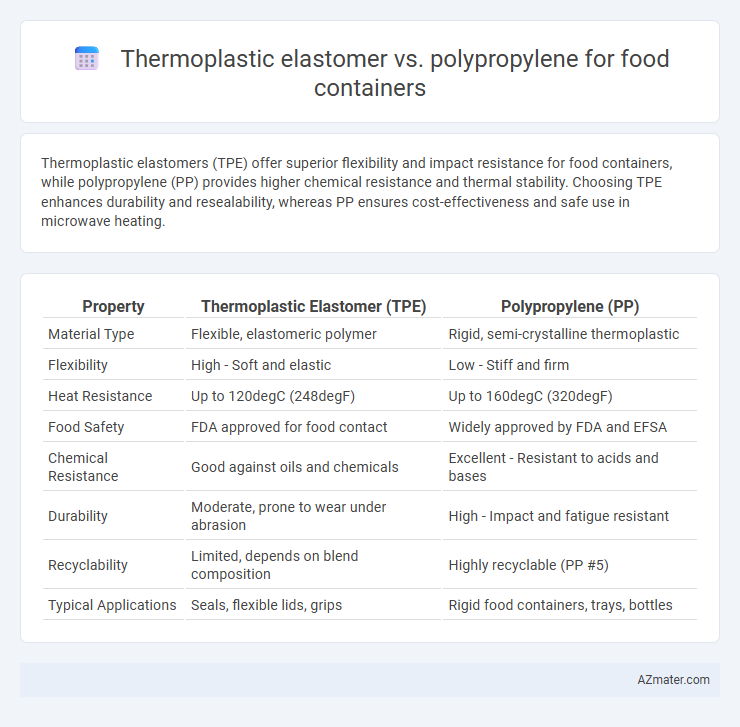Thermoplastic elastomers (TPE) offer superior flexibility and impact resistance for food containers, while polypropylene (PP) provides higher chemical resistance and thermal stability. Choosing TPE enhances durability and resealability, whereas PP ensures cost-effectiveness and safe use in microwave heating.
Table of Comparison
| Property | Thermoplastic Elastomer (TPE) | Polypropylene (PP) |
|---|---|---|
| Material Type | Flexible, elastomeric polymer | Rigid, semi-crystalline thermoplastic |
| Flexibility | High - Soft and elastic | Low - Stiff and firm |
| Heat Resistance | Up to 120degC (248degF) | Up to 160degC (320degF) |
| Food Safety | FDA approved for food contact | Widely approved by FDA and EFSA |
| Chemical Resistance | Good against oils and chemicals | Excellent - Resistant to acids and bases |
| Durability | Moderate, prone to wear under abrasion | High - Impact and fatigue resistant |
| Recyclability | Limited, depends on blend composition | Highly recyclable (PP #5) |
| Typical Applications | Seals, flexible lids, grips | Rigid food containers, trays, bottles |
Introduction to Food Container Materials
Thermoplastic elastomers (TPE) and polypropylene (PP) are commonly used materials in food container production due to their safety, durability, and chemical resistance. Polypropylene offers excellent heat resistance and rigidity, making it ideal for microwave-safe and stackable containers, while TPE provides superior flexibility and impact resistance, beneficial for containers requiring elasticity and seals. Both materials comply with FDA regulations for food contact, ensuring they maintain food safety and quality during storage and transport.
What is Thermoplastic Elastomer (TPE)?
Thermoplastic elastomer (TPE) is a versatile material combining the flexibility of rubber with the processability of thermoplastics, making it ideal for food containers that require durability and soft-touch properties. TPE offers excellent chemical resistance, temperature tolerance, and is BPA-free, ensuring food safety and compliance with FDA regulations. Compared to polypropylene, TPE provides superior elasticity and impact resistance, enhancing the user's grip and container longevity.
What is Polypropylene (PP)?
Polypropylene (PP) is a thermoplastic polymer widely used in food containers due to its excellent chemical resistance, high melting point around 160degC, and ability to maintain structural integrity under heat. Its non-toxic nature and resistance to moisture and oil make PP an ideal choice for reusable and microwave-safe food packaging. Compared to thermoplastic elastomers, PP offers greater rigidity and durability but lacks the flexibility and softness often desired in certain container applications.
Safety and Food-Grade Compliance: TPE vs Polypropylene
Thermoplastic elastomers (TPE) offer excellent flexibility and are often BPA-free, making them safe for food container seals and lids, while polypropylene (PP) is widely recognized for its high chemical resistance and FDA approval for direct food contact. PP demonstrates superior heat resistance, allowing for repeated microwave use without leaching harmful chemicals, whereas TPE, though food-grade, may have limitations in high-temperature applications. Both materials comply with stringent regulatory standards such as FDA and EU food contact regulations, but PP's long-standing usage in food packaging ensures broader acceptance for safety and food-grade compliance.
Durability and Longevity in Food Containers
Thermoplastic elastomers (TPE) offer superior flexibility and impact resistance compared to polypropylene (PP), enhancing durability in food containers subjected to frequent handling and temperature variations. Polypropylene excels in chemical resistance and heat tolerance, providing long-lasting performance in microwave and dishwasher use. While TPE containers resist cracking and deformation, PP containers maintain structural integrity over extended periods, making each material suitable based on specific use-case durability requirements.
Flexibility and Design Options
Thermoplastic elastomers (TPE) offer superior flexibility and elasticity compared to polypropylene (PP), making them ideal for food containers that require easy squeezing or bending without cracking. TPE materials support a wider range of design options including soft-touch finishes and complex shapes, enhancing ergonomic handling and aesthetic appeal. In contrast, polypropylene provides rigidity and high-temperature resistance but has limited flexibility and fewer customizable texture possibilities.
Heat Resistance and Microwave Suitability
Thermoplastic elastomers (TPE) offer superior heat resistance compared to polypropylene (PP), with TPE typically enduring temperatures up to 230degC while PP melts around 160-170degC. This higher heat tolerance makes TPE containers more suitable for microwave use, as they are less likely to deform or release harmful substances under prolonged heating. In contrast, polypropylene is microwave-safe for short durations but can warp or degrade if exposed to high microwave temperatures repeatedly.
Environmental Impact and Recyclability
Thermoplastic elastomers (TPEs) offer enhanced flexibility and durability for food containers but generally have lower recyclability rates compared to polypropylene (PP), which is widely accepted in recycling streams due to its uniform polymer structure. Polypropylene's environmental impact is considered lower because it can be recycled multiple times without significant degradation, reducing landfill waste and resource consumption. TPEs often require specialized recycling processes, limiting their environmental benefits despite their favorable mechanical properties.
Cost Comparison: TPE vs Polypropylene
Thermoplastic elastomers (TPE) generally have higher material and processing costs compared to polypropylene (PP), making PP more cost-effective for food container production. Polypropylene offers excellent balance between durability and affordability, resulting in lower overall production expenses. While TPE provides superior flexibility and impact resistance, the increased price often limits its use in cost-sensitive food packaging applications.
Which Material is Best for Food Containers?
Thermoplastic elastomers (TPE) offer superior flexibility, impact resistance, and excellent sealing properties, making them ideal for food containers requiring airtight and leak-proof features. Polypropylene (PP) provides high heat resistance, chemical stability, and is widely used for microwave-safe and dishwasher-safe food containers due to its low moisture absorption and inert nature. Choosing the best material depends on the container's specific use: TPE excels in flexible, squeeze-type containers, while polypropylene is preferred for rigid, heat-resistant, and durable food storage.

Infographic: Thermoplastic elastomer vs Polypropylene for Food container
 azmater.com
azmater.com